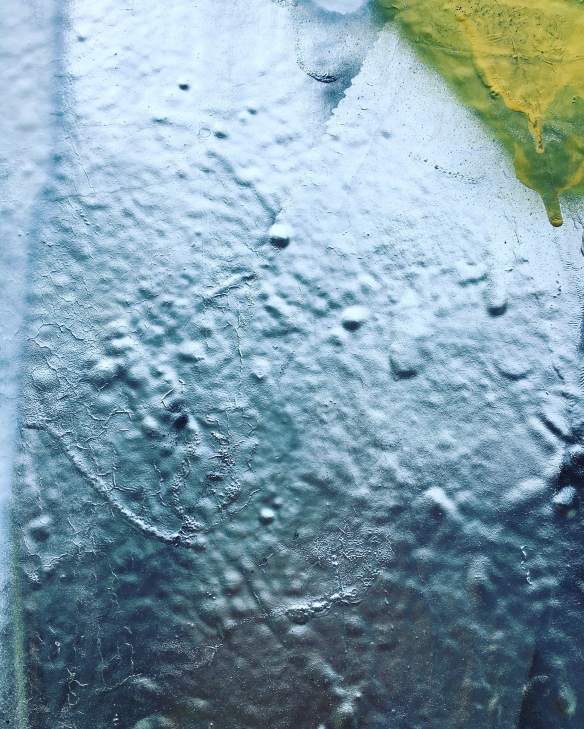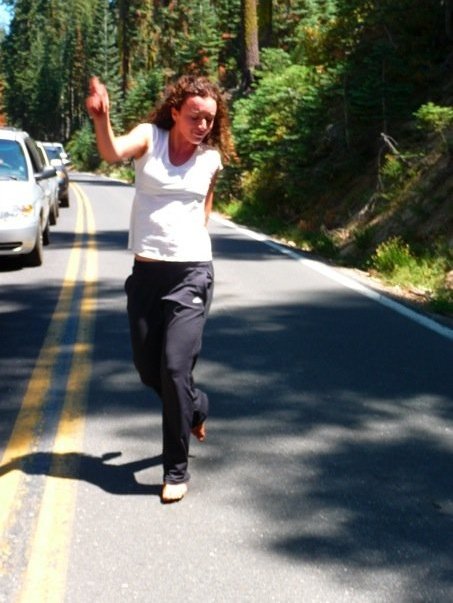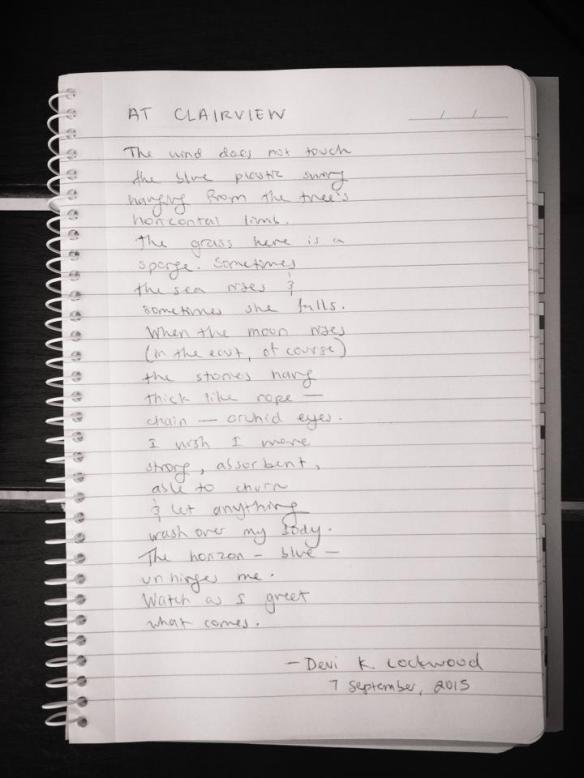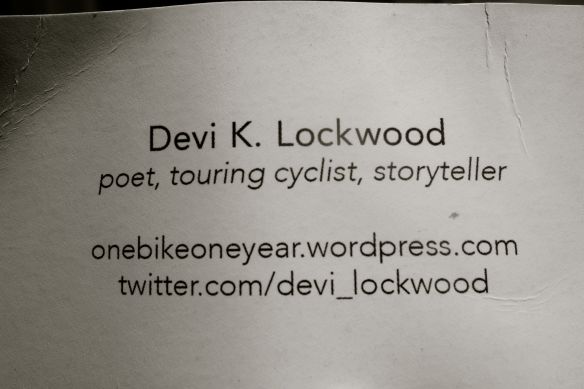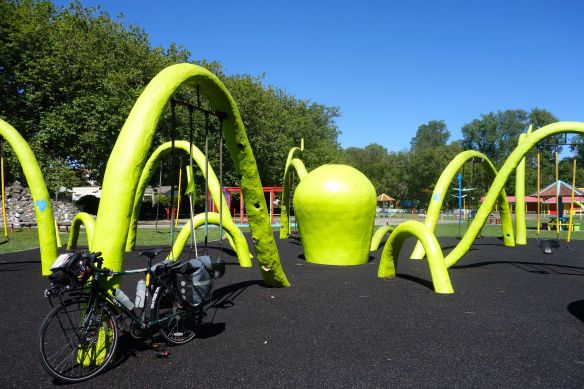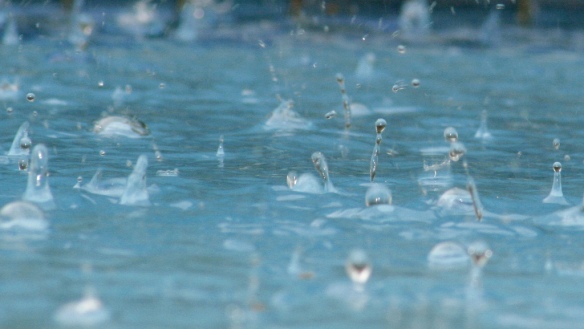Back when I was planning my first solo bike trip in 2013, I typed the words “poet” and “touring cyclist” into a Google search bar, just to see if there were others like me… and goodness am I glad that I did!
Though we have yet to meet in person, Maya Rachel Stein has been a lighthouse in my writing process––she inspires me to write more, and with a steady rotation of patience, love, and an eye to complexity. Maya recently completed Type Rider II, a 1400 mile tandem trip from Boulder, Colorado to Beloit, Wisconsin. Along the way, Maya and her partner Amy built more than 20 Little Free Libraries and promoted poetry, community, a love of reading, and a spirit of collaboration.
Back in 2012, Maya rode 1200 miles from Amherst, Massachusetts to Milwaukee, Wisconsin towing a typewriter behind her. At each stop on this Type Rider tour, she invited people to contribute to a collaborative poem.
Thanks to Google, I know that there are other cycling poets out there, and dang am I glad not to be alone.
What inspired you to take the Type Rider tour?
The first Type Rider adventure was really born out an experience I had as a kid, growing up in rural New Hampshire. We had this sort of foyer upstairs that linked up our bedrooms, and my dad had put a typewriter there on a desk that no one was using. One day, he started the first lines of fantastical story, and my sister and I each contributed a line or two that followed. Then it started to become a nightly habit, peeking at the paper and seeing where the story was going, then adding our individual twists. We took turns writing this collaborative story for over two years, and almost 30 years later, I was walking down the main street in Amherst, Massachusetts and saw turquoise-blue typewriter in the window of Amherst Typewriter and Computer. Something about it transported me back to that hallway in New Hampshire, and I started thinking about what it would be like to recreate the experience of collaborative storytelling, but bringing it outward to the larger community. Later, I was with a friend sort of riffing in the word “typewriter.” I broke it down into two word – “type” and “writer” and when I said it enough times “writer” turned into “rider.” I drew this very quick sketch of a woman riding a bicycle with a typewriter behind her in a trailer. When I did some research about typewriters and discovered that the first commercial one had been invented in Milwaukee, Wisconsin, it seemed natural that I would go there. I was turning 40 that spring and decided to leave on my birthday, and take 40 days to get to Milwaukee, which meant about 30-40 miles a day. I bought the turquoise-blue typewriter and a little tow trailer, along with a folding table and chair. The idea was to stop each day, set everything up, put a new writing prompt at the top of the page, and invite anyone I met to respond to it. I called it Type Rider: Cycling the Great American Poem. The writings that came out of it were amazing. The whole adventure moved me in so many ways, and I just wanted to keep going.
And so I did, a little over two years later. This time, I took my partner, Amy. We were approached by the Little Free Library organization about doing some kind of trip to visit part of their network of community book exchanges. We decided to go a few steps further, raised money to fund the building of 25 more libraries, and decided on a 30-day tandem bicycle ride through four states in the Midwest. The theme of Type Rider II: The Tandem Poetry Tour was creativity, collaboration, and community. Amy and I rode the tandem, brought along two typewriters, and offered up an activity we called Tandem Poetry. The gist is, someone gives us a word and we each write them a poem on an index card. We work side by side, not talking really, just writing. It’s a very powerful experience to be doing something so typically private out in the open. But the point of it was to make the writing process more transparent, to show people ways they could make creating fun, and giving the poems away for free so that the people in the communities we visited had a lasting memory of our time there. It was an unforgettable trip that I feel very lucky to have been able to experience with someone I love.
How does touring with yourself compare to touring with a partner?
In each of the Type Rider adventures, I was joined by a friend who drove a support vehicle throughout the trip. Which is another story altogether, I think – what it means to share in this experience with someone who sees it on the inside. Having a partner with me was an even more intensive and intimate experience. But I would never have done this with Amy had I not felt a solid foundation between us. I didn’t know how well the biking was going to work, but having worked together with her and shared so much time and experience together, I was pretty confident that we would make it through okay. It’s not to say that we didn’t run up against conflicts or roadblocks. But even these we sailed through quickly. I think we both understood the stretch that this project was asking us to make, and I think we both rose to the occasion to make things work as best as they could. And I absolutely loved being able to share this adventure with her because of the shared experiences it was giving us. They were a gift daily, hourly. There were times that I missed riding alone, but I wouldn’t have traded it for what we did together.
What story sticks out in your mind when you think back to Type Rider II?
It’s not a story so much because it only lasted a moment. But something happened internally when we passed the state line from Colorado into Nebraska. We were in the middle of absolutely nowhere and this big sign rose out of the shoulder of this old highway we were riding on. I felt the expanse of the country itself, and felt the expanse of the landscape within me. It was a kind of spiritual alignment with my surroundings, a connection to my purpose and my passion and my vision and the absolute gratitude I felt that I was exactly right where I was. This feeling like there was no place else I needed or would have preferred to be. I have those moments once in a while when I’m writing. It’s a symbiosis. A congruency. A deep sense of belonging.
Talk to me about typewriters and bicycles. What is their allure for you?
They’re entirely analog, human-powered machines. There are no computers or shortcuts. You have to make do with your own capacities, and you get confronted with the limits of those capacities. I think they can humble us in really good ways.
Why do you write?
Because there is so much to write about that is too hard to say.
Who were the best writing teachers you had in your life? What were they like?
In high school I had two. I don’t think I’ve ever worked so hard on my writing as I did then. But they insisted on it. They saw a potential and a skill in my work and they made it impossible for me to “dial it in.” I also had a wonderful mentorship with Deena Metzger for about 9 years, when each summer I’d attend her Writers Intensive in southern California. Again, she saw something in me and wouldn’t back down until I pulled it out on the page. It was rigorous and painful and hard as hell, but that’s exactly what I needed at the time. She taught me how to be a better editor of my own work, and her teachings have helped me tremendously in the writing classes and retreats I facilitate.
In six words or less, what nuggets of truth do you hope to pass along to writers who take your workshop?
Take your time.
Do you have any stories related to water or climate change that you would like to share?
The first thing that comes to mind is that I recently had my birth chart read by an astrologer friend and she told me that I had no water in my chart at all. I was surprised – I thought for certain I must have it. (As Eve Ensler wrote, “I am an emotional creature.”) But I am also aware of my ambivalence around water. I’d usually rather look at it than be in it. I like solid ground. Water is unpredictable, uneven, and uncontrollable. Which also may explain why it’s probably one of my best teachers.
Who inspires you?
Smart, nerdy kids. I want to say to them, “I know it may not look like it now, but you have no idea how you’re going to change the world.”
What are you reading right now?
Gone Girl by Gillian Flynn. Someone put it in the Little Free Library that’s on our front lawn, and I thought I’d read it in case I wanted to see the movie.
What projects are you working on?
Type Rider III is definitely in the pipeline. Amy & I also run a mobile creativity company called Food for the Soul Train. We started it about a year-and-a-half ago. We teach art and writing classes in northern New Jersey, run a school program involving typewriters and poetry and tiny books and we bought a vintage caravan we call MAUDE (Mobile Art Unit Designed for Everyone) to serve as mini-classroom, photo booth for birthday parties, and home away from home when we travel.
What is your favorite place on earth?
The beach near the Mauna Kea hotel on the west side of the Big Island of Hawaii, just before sunrise.
What’s your favorite word?
“Citrus” is right up there.
How do movement and writing intersect in your work?
I’m very good with being quiet and sitting still. In fact, I think my best work comes from carving out that space as much as I can. But it doesn’t work if that’s all of it. Maybe it’s all those years of being a tomboy, playing in the dirt, running around basketball courts, but I think part of the richness of stillness and quiet comes from being on the other end of movement and activity. I believe that any kind of physical engagement can actually be wonderfully generative and nutritive environment to work out my creative kinks. So when I’m noticing a lull or a lack of energy around creativity, I almost always take a walk or – better yet – get on my bicycle. It’s tremendously restorative to feel my heart racing.
Is there anything else you’d like to add?
I am full of recessive genes: left-handedness, auburn hair, freckles, and green eyes. Someone is always coming up and telling me I look like someone they went to camp with.
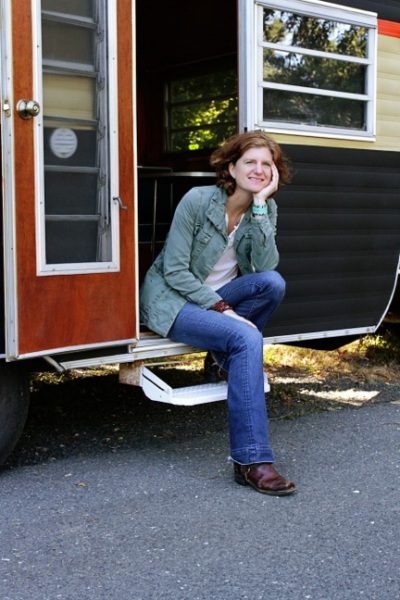 Maya Stein is a Ninja poet, writing guide, and creative adventuress. She wrote her first poem, “Papa Tree and the Seasons,” when she was 9 years old. It told the story of the life cycle of leaves, honing specifically on the fate of one little leaf that is the last one clinging before winter comes. She bound this poem into a little book, filled it with color pencil drawings, and proudly offered it up to her parents one evening. She sees now that this quite accurately represents the instincts behind most of her work to date – the desire to capture that which is most fleeting, to locate the heart of its beauty and power, sustain its life through language, and share that language with others. Maya has since self-published four collections of writing, most recently “How We Are Not Alone,” a compilation of work from her poetry blog. Since 2005, Maya has kept a weekly writing practice, “10-line Tuesday,” and her poems now reach more than 1,200 people each week. She also leads “Feral Writing” workshops, both live and online, providing mentorship and guiding students through simple, often playful exercises and activities that help strengthen their creative instincts and develop a writing practice that sticks. Among her latest escapades are a 30-day tandem bicycle journey through the Midwest, a French crepe stand at a Massachusetts farmers market, a relocation from San Francisco to suburban New Jersey and most recently, a collaboration—Food for the Soul Train— turning a vintage trailer into a mobile creative workshop space with her partner. Her favorite body part is her left hand, as it has gifted her with the ability to sink a nearly invincible hook shot, peel a whole apple without a break, and transcribe the poems living in her heart. You can learn more about Maya’s adventures at http://www.mayastein.com.
Maya Stein is a Ninja poet, writing guide, and creative adventuress. She wrote her first poem, “Papa Tree and the Seasons,” when she was 9 years old. It told the story of the life cycle of leaves, honing specifically on the fate of one little leaf that is the last one clinging before winter comes. She bound this poem into a little book, filled it with color pencil drawings, and proudly offered it up to her parents one evening. She sees now that this quite accurately represents the instincts behind most of her work to date – the desire to capture that which is most fleeting, to locate the heart of its beauty and power, sustain its life through language, and share that language with others. Maya has since self-published four collections of writing, most recently “How We Are Not Alone,” a compilation of work from her poetry blog. Since 2005, Maya has kept a weekly writing practice, “10-line Tuesday,” and her poems now reach more than 1,200 people each week. She also leads “Feral Writing” workshops, both live and online, providing mentorship and guiding students through simple, often playful exercises and activities that help strengthen their creative instincts and develop a writing practice that sticks. Among her latest escapades are a 30-day tandem bicycle journey through the Midwest, a French crepe stand at a Massachusetts farmers market, a relocation from San Francisco to suburban New Jersey and most recently, a collaboration—Food for the Soul Train— turning a vintage trailer into a mobile creative workshop space with her partner. Her favorite body part is her left hand, as it has gifted her with the ability to sink a nearly invincible hook shot, peel a whole apple without a break, and transcribe the poems living in her heart. You can learn more about Maya’s adventures at http://www.mayastein.com.
